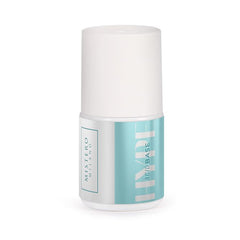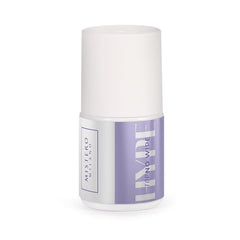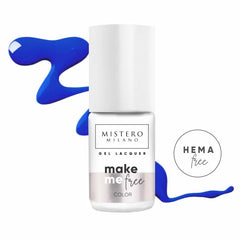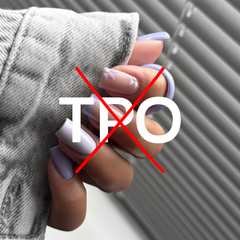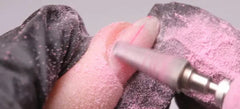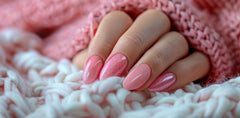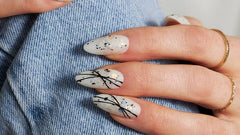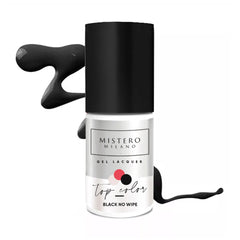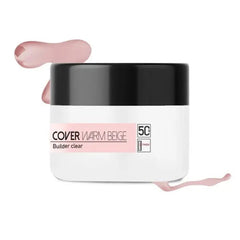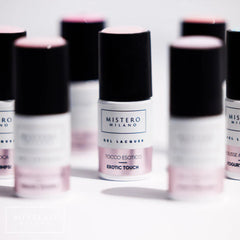Contact allergy
Amber D'Halluin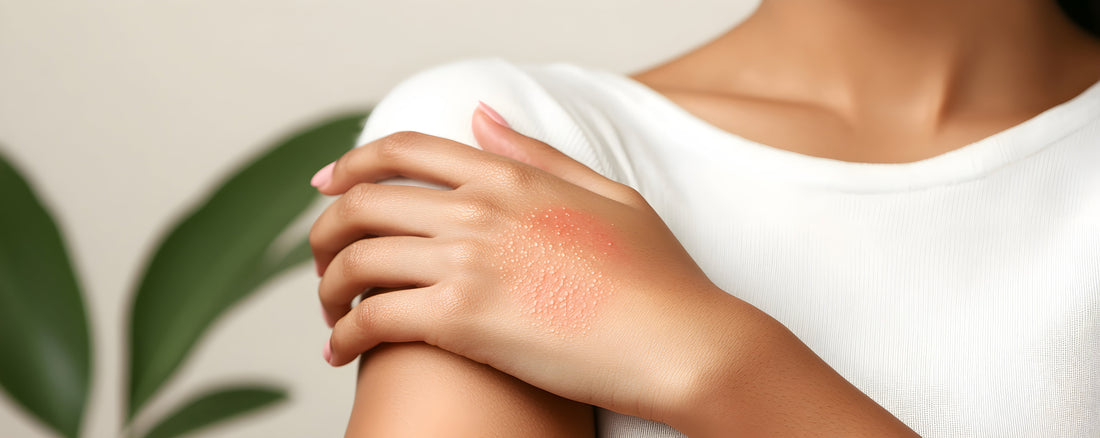
1. What is a contact allergy?
Contact allergy, also known as allergic contact dermatitis or contact eczema. It is usually caused by specific ingredients present in nail products and not by the nail product itself. This allergic reaction can occur with different types of products and brands. Fragrances and preservatives are often the culprits in allergic reactions to cosmetics.
Developing an allergy to a certain substance is not self-evident. Long-term or repeated contact between the skin and a nail product can lead to an allergic reaction. A substance or ingredient that causes allergies is called an allergen. The symptoms of a contact allergy are usually similar to the symptoms of an irritation.
2. What causes an allergic reaction?
If you use nail products often, you may notice that your skin becomes irritated one day. This could be a sign of contact allergy, a condition in which your immune system reacts to certain ingredients in the nail products (acrylates).
There are several reasons why contact allergy can occur with artificial nails. One of the most common causes is damaged cuticles and nails. Your body is directly exposed to uncured artificial nail mass.
Another cause of contact allergy with artificial nails is the use of poorly cured nail products. This can happen if you use the wrong lamp, or if you do not respect the curing times.
Working with poor quality products can also be a reason for contact allergy. It is therefore important to always use high quality products.
Finally, unhygienic work can also lead to contact allergy with artificial nails. For nail stylists, this can be a dirty brush, for example, while customers can have unwanted skin contact with spilled nail products.
If you suffer from contact allergy to artificial nails, it is important to immediately stop using nail products and consult a dermatologist. A dermatologist can help you find the right treatment and prevent further complications.
3. What are the symptoms of a contact allergy?
Those who regularly wear artificial nails should be alert to symptoms of a possible allergic reaction, which often resemble irritation and usually manifest on the fingers.
It is important to know that the symptoms of an allergic reaction do not appear immediately. Sometimes it can take months or even years for an allergic reaction to fully develop. If you notice symptoms, it is essential to remove your artificial nails immediately to minimize damage. Using a nail file or a nail drill is the best option for this, as using removers can worsen the symptoms. It is not the acetone that you are allergic to, but the substances that are released during soaking.
Symptoms of artificial nail contact allergy can vary, but some common symptoms include:
- Severe itching
- Small blisters
- Redness
- Pain
- Swelling of the fingers
- Loosening of the nail and your nail bed
An allergic reaction may involve other parts of your body showing symptoms, such as swelling or other symptoms on the face, eyelids, glands in the throat or groin. Some people also get hives, although this is less common. Hives can occur on the neck, wrists, arms or face.
4. What can be the consequences of an allergy to acrylates?
An allergic reaction to acrylates can have serious consequences. It can lead to the rejection of various prostheses and medical devices , including hip and dental prostheses, pacemakers, bone cement, etc. It is very important to use the correct technique when applying artificial nails and to follow adequate training, to prevent contact allergies or allergies to acrylates.
Ensuring a high level of hygiene by the chosen nail technician is also crucial. Strict adherence to hygiene practices is essential to minimize the risk of contact allergies during a manicure.
5. What is the difference between an allergy and an irritation?
Have you ever wondered what the difference is between an irritation and an allergy? It is important to understand the difference.
An irritation is usually a short-term reaction to a product or substance. You can think of red spots, itching or inflammation. But the most important thing is that these symptoms disappear when you remove the product or substance. If you come into contact with the same substance again later, you will probably not react immediately.
Unlike an irritation, the symptoms of an allergic reaction always return when you come into contact with the allergen.
It is important to know that if you experience irritation symptoms repeatedly, you are probably developing an allergy. Think of irritation on your hands when using a gel brush with a dirty handle. If you do this for months, this can lead to a contact allergy due to prolonged and repeated exposure.
Although the symptoms of irritation and allergy can be similar, it is important to know the difference. Many people think they have an allergy when it is just an irritation. To be sure about the cause of your symptoms, we recommend that you contact a dermatologist. A dermatologist can perform a patch test to determine the cause of your symptoms and can give you the best treatment.
6. How do I know if I am allergic to nail products?
Do you suffer from repeated skin irritation when using nail products? Then it is possible that you are allergic to certain ingredients. To find out exactly which substances you should avoid, it is best to have a special allergy test performed by a dermatologist.
It is important to note that this is an allergy test for nail products, so the patch test can be adapted accordingly.
During this test, various substances that you are probably allergic to are applied with special stickers. These stickers are usually applied to your back or upper arm and must remain on your skin for two days.
After two days, the stickers are removed and the test sites are examined for reactions. In order not to miss anything, the places where the stickers were located are marked with a marker. Then follows a waiting period of four days on average.
After the waiting period, you return to the dermatologist for a check-up. During this check-up, they will see if you have reacted to something clearly. Possible reactions are:
- Redness
- Swelling
- Blisters
The substances that test most positively for a contact allergy include:
- Tosylamide
- Formaldehyde resin
- Methyl methacrylate monomer (MMA)
- Methacrylic acid esters
- Ethyl acetate
- Butyl acetate
- Alkalis
List of substances according to DermNet , the authority in skin information.
It is important to know which ingredients to avoid in order to prevent contact allergy. By performing an allergy test, you can get the right treatment and ensure that you are using nail products that are safe for your skin. So don’t take any chances and get an allergy test done by a dermatologist if you suspect that you are allergic to a certain nail product.
7. What can you do about this allergy?
Are you experiencing an allergic reaction or irritation from your artificial nails? It is best to have your artificial nails removed immediately to prevent further damage. The longer you wait, the worse the symptoms can become. When you remove the artificial nails, the epidermis can regenerate and the allergic reaction or irritation will eventually stop. It is important to wait until the epidermis has completely healed before having new artificial nails applied.
8. How can I prevent an allergic reaction?
Do you want to prevent a skin allergy (contact allergy)? Then it is wise to avoid prolonged and repeated contact with certain substances. Keep in mind that an allergy never completely disappears. The symptoms can always return when you are exposed to the substance that caused the allergy. But what if you accidentally come into contact with the allergen and an allergic reaction occurs? In that case, you can temporarily use a cream with corticosteroids to relieve the symptoms. However, it is important to remember that this is only a temporary solution and that you should avoid contact with the substance in the future to prevent further allergic reactions. Take good care of your skin and avoid prolonged and repeated contact with possible allergens!
9. Can acetone cause skin allergies?
Acetone is often used in nail salons to remove artificial nails. However, there is a lot of confusion about the possible allergic reactions that acetone can cause. Contrary to popular belief, acetone itself cannot cause skin allergies or any reactions.
Why not? Well, the chemical structure of acetone does not cause immune reactions. In fact, acetone is naturally found in our bodies as a byproduct of our food metabolism. So it would not make sense for our bodies to become allergic to a substance that is naturally present in our bodies.
But that does not mean that there is no danger in using acetone in nail salons. Allergic reactions can occur due to certain substances that are released during soaking. This mainly occurs with artificial nails that have not been sufficiently hardened and therefore come into direct contact with the skin. That is why it is important to always use a good lamp and to follow the hardening times carefully.
Although acetone itself cannot cause allergic reactions, it can cause dry or irritated skin. If you experience this, you can use a moisturizer to hydrate your skin.
10. Are there hypoallergenic nail products?
If you are looking for hypoallergenic nail products, chances are you are wondering if they exist. The answer is yes and no. We do our best to develop products with as few allergens as possible, but we can never guarantee that you will not react to them. That is why we always recommend doing a patch test before applying the product to your nails.
It is crucial to understand that hypoallergenic means that the product contains fewer allergens than normal, but this does not mean that it is 100% allergy-free. It is an abstract concept because what means little to one person can mean a lot to another. In addition, there can still be allergens present in the product that you can react to. We think hypoallergenic is rather an often abused marketing term.
If you do get an allergic reaction, it is important to know which substance you are allergic to. You can always check on our product pages whether this substance is present in our products.
It is therefore important to inform yourself well about the ingredients of the nail products you use and to always be careful when applying them. If you have any doubts about whether you will have an allergic reaction, consult a dermatologist.
Disclaimer: We do our best to write this as accurately as possible, but we are not dermatologists. If you have any problems or doubts, please contact your local dermatologist.

